Learn how to make the most flavorful and tender smoked sirloin steak that can stand up to any filet mignon! Sirloin filet is perfectly seasoned with a beef rub and then smoked to perfection. This is sure to become your new favorite Traeger steak recipe. These steaks will melt in your mouth!
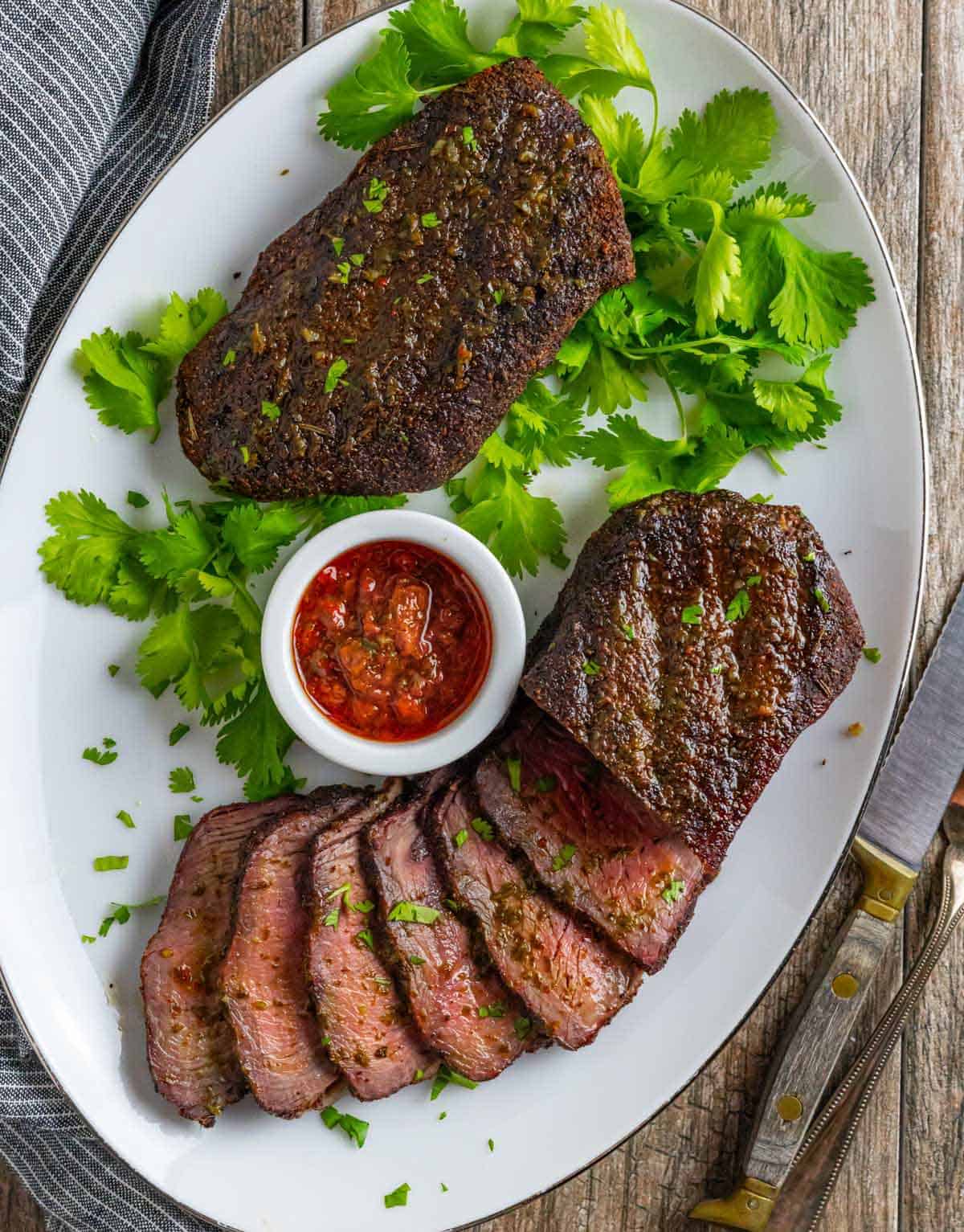
Jump to:
Making a smoked sirloin steak on the Traeger has been one the most rewarding smoker experiences I’ve had. I never considered this cut of meat to be particularly flavorful or tender. I like lean steak and have always been partial to tenderloin made in cast iron with this All-Purpose Seasoning, or smoking a Flank Steak with simple salt and pepper. I’m so glad I branched out and decided to try this Traeger sirloin steak with a savory Beef Dry Rub – it’s completely changed my mind about sirloin and its now one of my favorite cuts.
This Traeger top sirloin recipe uses a dry marinade made from simple herbs and aromatics that creates a beautiful crust on the outside, while the inside stays tender and juicy. With this recipe, you have perfectly cooked steaks that are ready in about an hour. Make this for an easy weeknight dinner, date night or any special occasion.
Why you’ll love this recipe
- Tender and mouthwatering – this recipe makes truly great steaks with amazing flavor
- Economical – making a smoked top sirloin steak is budget-friendly, using an economical cut of beef
- Easy and simple prep – simply apply a dry rub and the smoker does the rest
- Special diet friendly – sirloin is a great source of healthy and lean protein. Beef is low-FODMAP, low-carb, paleo, AIP and Whole30 compliant.
Ribeye vs Sirloin vs Filet
These three are the most famous cuts of steak, are available in most grocery stores and are equally delicious in their own right. However, there are certain qualities to each cut to consider.
What is sirloin steak? It is a very versatile cut because it’s quite lean and is much more economical than ribeye or tenderloin (filet mignon). Sirloin has a more sturdy chew, firmer texture and has less of a robust, beefy flavor than ribeye, due to less marbling. Sirloin comes from a large cut of meat from the center or rear spine of the steer and gets cut into several other cuts of steak or roasts.
Ribeye is cut from the rib cage area and is fattier than other cuts. The flavor is rich and strong due to considerable marbling and is also more tender than sirloin due to its higher fat content. They can be found bone-in or boneless, with a price point noticeably higher than that of sirloin.
Filet mignon (or tenderloin) is a luxurious, tender cut that comes from an area beneath the ribs, next to the backbone of the steer. It’s a small, expensive cut that is lean, with a buttery tenderness, making it the most prized portion of the animal. Filet has a mild but rich flavor and a soft texture. It has less beefy flavor than ribeye or sirloin, but has superior tenderness.
Prime vs Choice beef
Both are USDA designations that reflect a quality grade of beef. Grading is based on the age of the animal and amount of marbling present. Prime grade reflects more marbling (which brings more flavor), comes from young cattle and is the most tender meat. While Choice also comes from younger cattle, it has moderate marbling, yielding a milder flavor, chewier meat and lower price point.
Both are excellent cuts of beef, perfect for low and slow cooking.
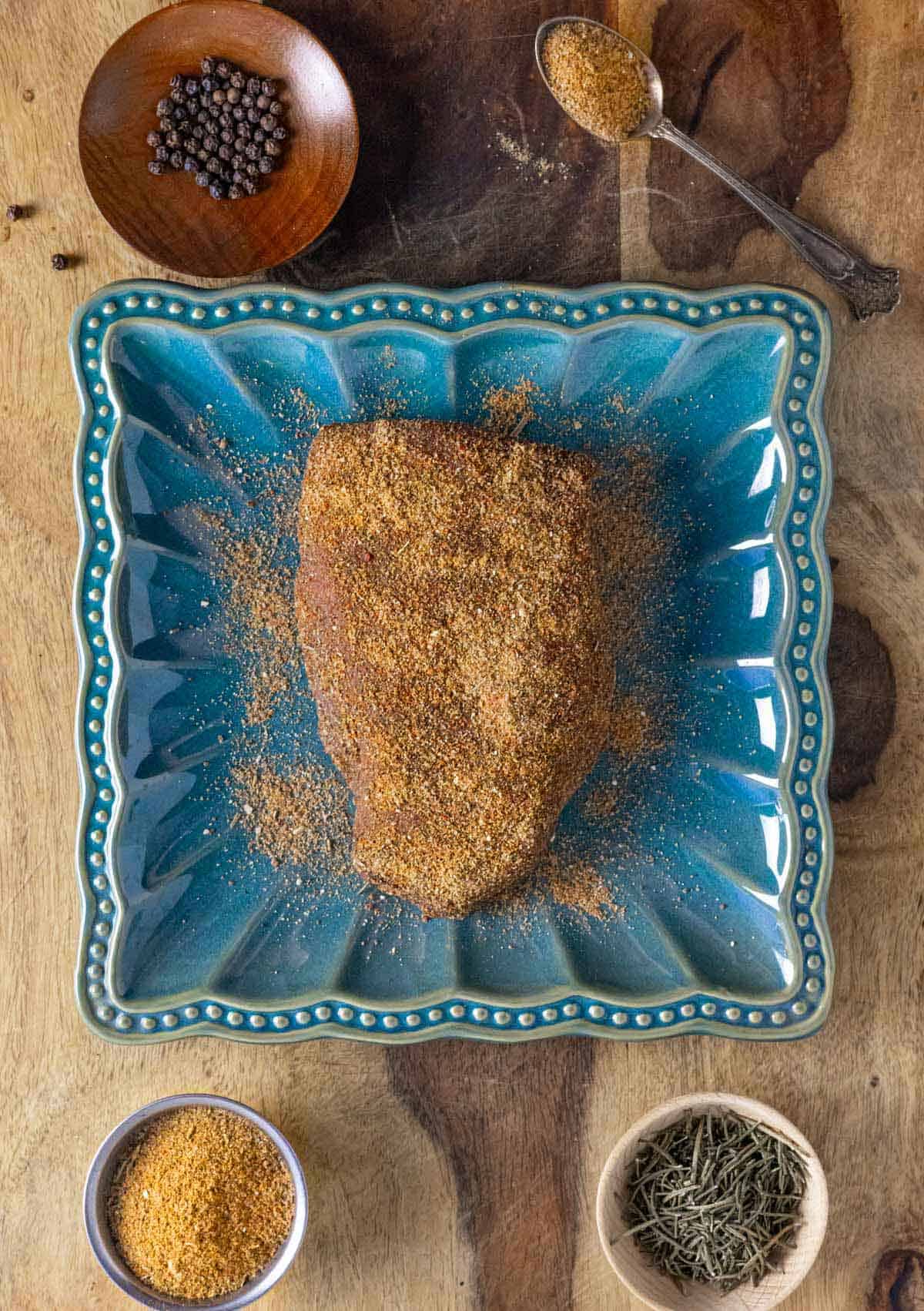
Ingredients
- Sirloin steak – thicker cuts will take longer to smoke than thinner cuts. I recommend steaks that are at least 1-inch thick or more.
- Steak rub – use your favorite spice blend or simple salt and pepper. I love to use either All-Purpose Seasoning or my Beef Rub (pictured above).
Instructions
These instructions are to cook to medium doneness, using a reverse sear method, which means the steaks are seared after smoking. This allows more smoke to penetrate into the meat, for maximum flavor.
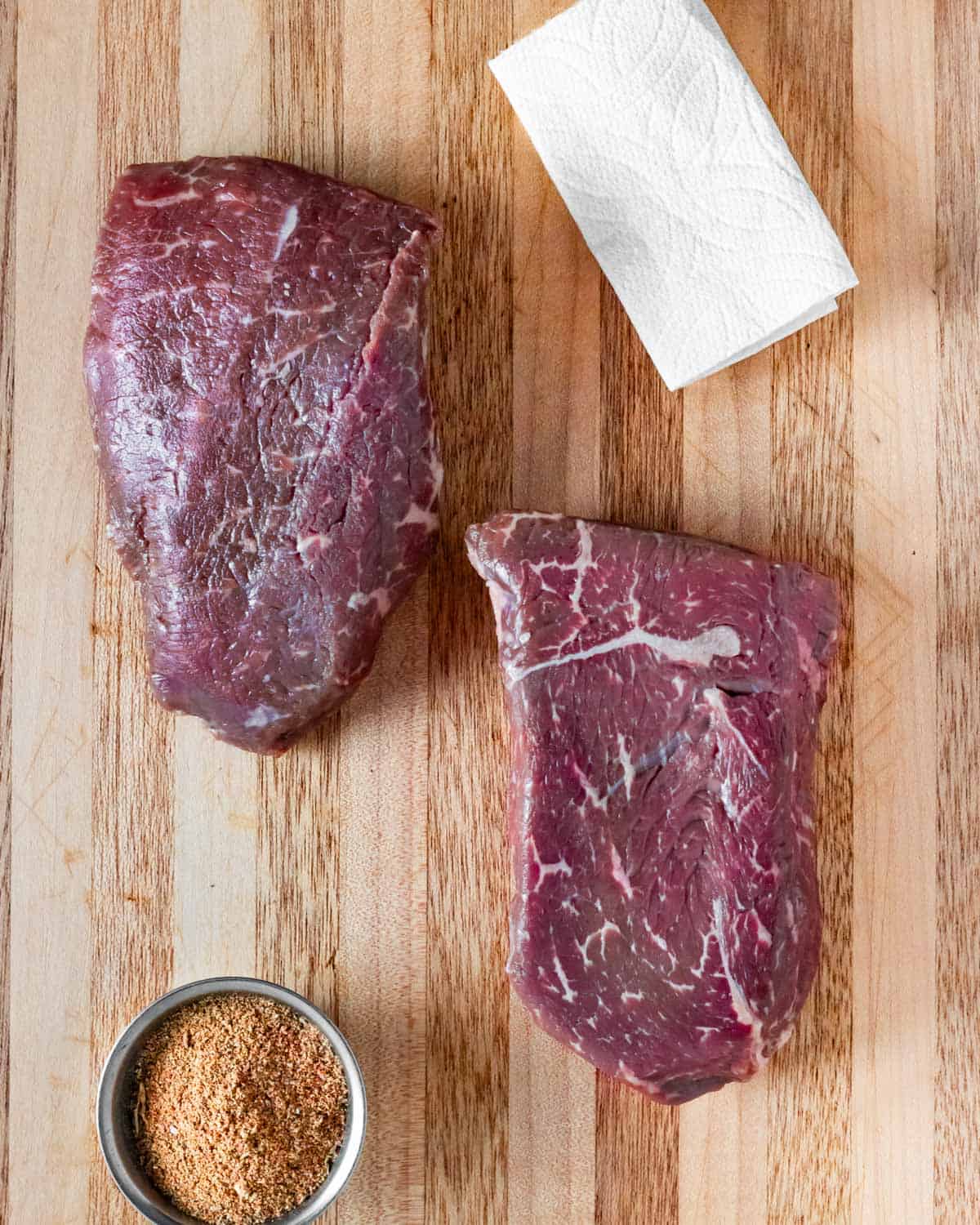
Pat the steak dry with a paper towel.
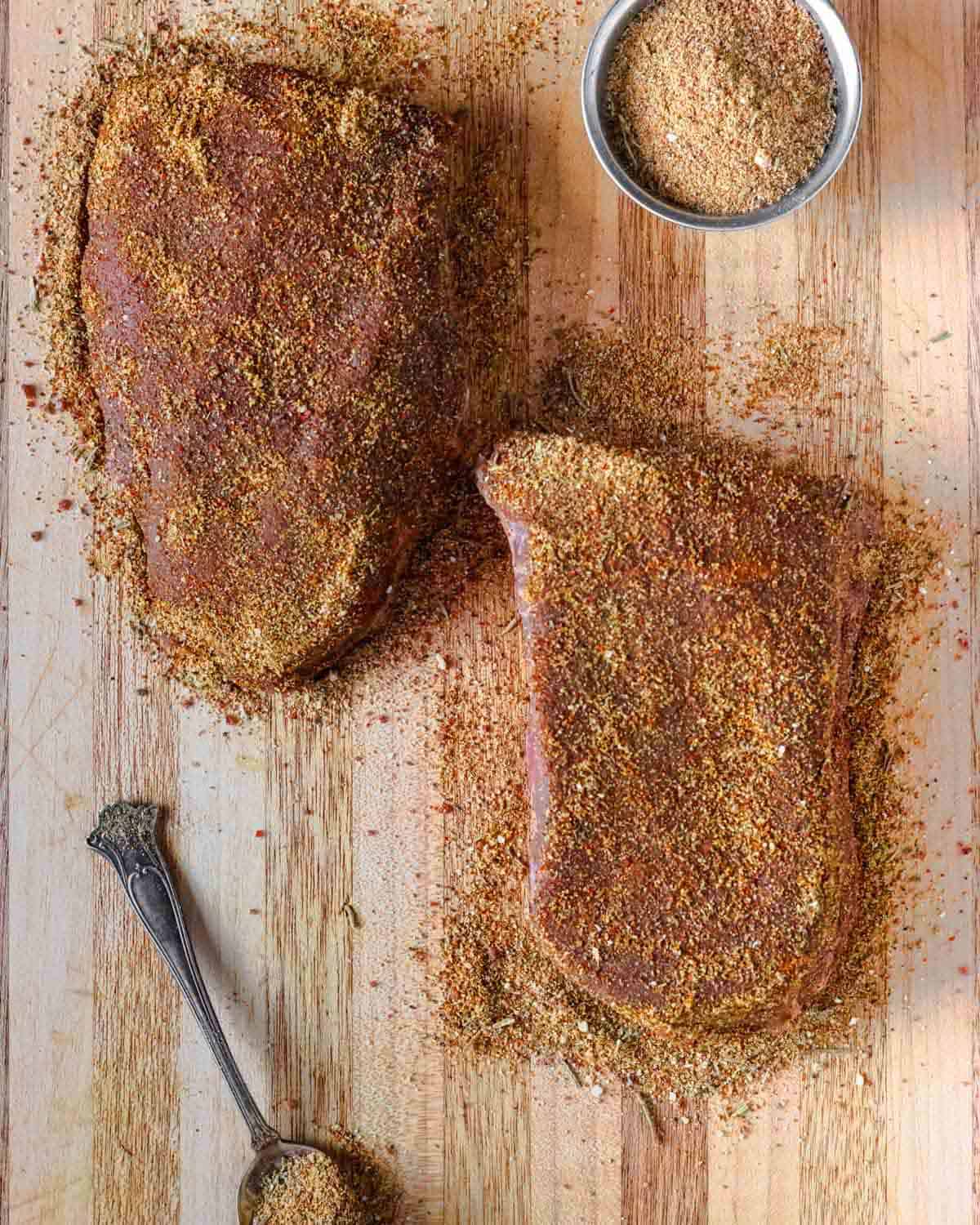
- Cover all sides with steak rub (dry brining). Dry brining brings out natural flavors of meat and improves the texture. Salt draws moisture to the surface, which is then absorbed back into the meat, acting as a natural tenderizer.
- Let marinate for at least 30 minutes before cooking, and up to 24 hours.
Pre-heat the smoker to 225°F.
For more even cooking, when ready to smoke, let the steaks come to room temperature before placing in the smoker by setting them out for about 30 minutes.

- Place on the grill and smoke until internal temperature reaches about 130°F, about 45 minutes
- Remove from the smoker, cover with foil and increase heat to 450 °F (See Expert Tips)
- Return the steak to the smoker and sear for 3 to 3.5 minutes on each side, until internal temp reaches 140-145°F or your preferred level of doneness (See Expert Tips)
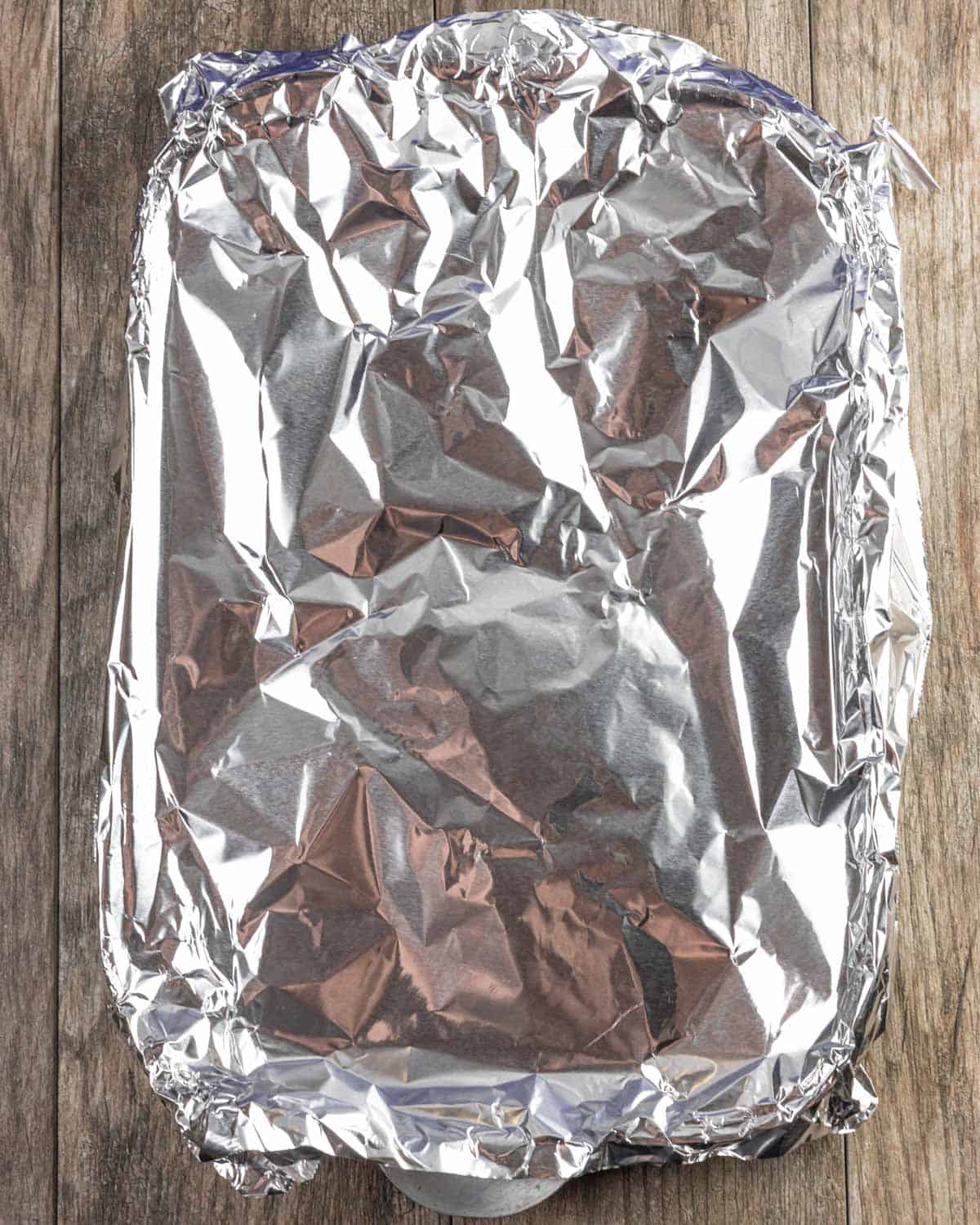
Remove from the grill and let rest, covered for at least 5 minutes. Carryover cooking will raise the internal temperature 5-10°F while the steak is resting (see Expert Tips).
Expert tips
- Removing the steak from the grill while the smoker increases temperature between the smoking and searing steps is essential to prevent overcooking.
- Resting is an essential part of the cooking process. The meat increases in temperature during this time (called carryover cooking) and juices get reabsorbed and redistributed in the muscle fibers, creating a moist and flavorful steak.
Doneness of steak temperature guide
After searing, the meat should be removed from the grill when the thermometer reads 5°F-10°F lower than your desired level of doneness, as the temperature will continue to rise during the resting period. However, this will vary depending on the cut of meat.
For these steaks, I removed them at 140°F for a perfect medium doneness after resting.
Here are general guidelines for doneness based on internal temperature:
- Rare - the outside is seared with a cool red center. Temperature is about 125°F
- Medium rare - the center is warmer red and temperature is about 135°F
- Medium - the center is a warm pink and temperature is about 145°F
- Medium well - has a slightly pink center and temperature is about 155°F
- Well done - has no pink and temperature is about 165°F
USDA recommends beef steaks and roasts be cooked to at least 145°F (medium) to ensure food safety.

I used a Meater Plus Bluetooth Thermometer for this recipe. The beauty of this thermometer is that you can monitor internal temperature without having to open the lid. You get all of the information you need in the app right on your phone! It’s a very cool gadget.
Otherwise, I love using my handheld Thermopro thermometer, which quickly checks internal temperature so I can minimize the time the lid is open.
Best wood to smoke steak on a pellet grill
More robust woods like oak and hickory compliment the flavor of beef. Apple, pecan and cherry are also great options on their own or can be added to other woods to balance out the flavor.
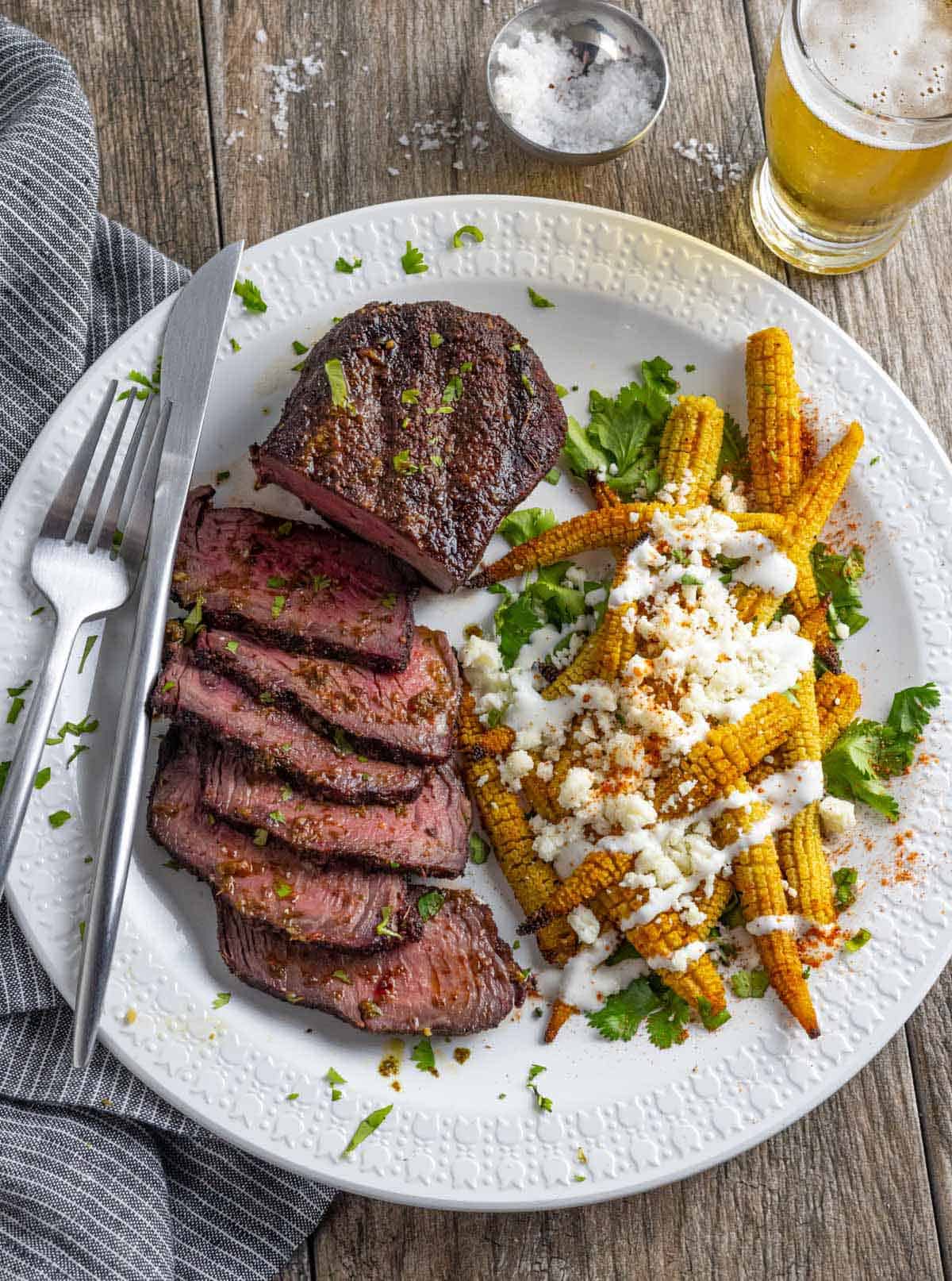
How to serve
- With a side salad – serve with this delicious Microgreens Salad with Roasted Baby Corn topped with cotija cheese and crema, or with a Burrata Caprese salad using fresh tomatoes, basil and creamy burrata cheese
- Steak sauce – Green Chimichurri, Horseradish Mustard Sauce and Red Chimichurri are phenomenal with steak
- With favorite sides – serve with Gluten-free Cilantro Lime Coleslaw, Smoked Portobello Mushrooms and Cheddar Drop Biscuits for a wonderful meal
- Sirloin steak salad – slice and top your favorite greens, like a Kale BLT Salad or a Beet and Feta Salad for a healthy dinner
- Sandwiches – leftovers make amazing sirloin steak sandwiches made with Low-carb Sandwich Thins or Parmesan Oregano Bread
How to store
Store in an airtight container in the refrigerator for up to 4 days or consider freezing for up to 6 months.
FAQ
There are three different kinds of sirloin: Sirloin, Top sirloin and Bottom sirloin. All are commonly referred to as ‘sirloin’ and are cut into several different cuts of steak and roast. Sirloin and Top sirloin are located over and under the tenderloin (respectively). These are the most tender and flavorful of the sirloin cuts, are well-marbled and juicy. Bottom sirloin is a tougher cut and is divided into several cuts, including tri-tip and flap steak or is typically ground or made into stew meat.
Dry brining is a technique that involves salting food and letting it marinate in the refrigerator prior to cooking. The salt draws moisture to the surface which is then re-absorbed into the meat, making it more tender, juicy and flavorful.
Yes, steak is a healthy FODMAP-friendly food because it is a pure protein and doesn’t contain any indigestible sugars.
Yes, when consumed in moderation. It is high in protein, iron and other nutrients, while being lower in fat and cholesterol.
Steak can be marinated for as little as 20 minutes or as long as 24 hours before cooking. If marinated longer, the meat fibers start to break down, causing the texture to become too soft and slightly mushy.
More seasonings for steak
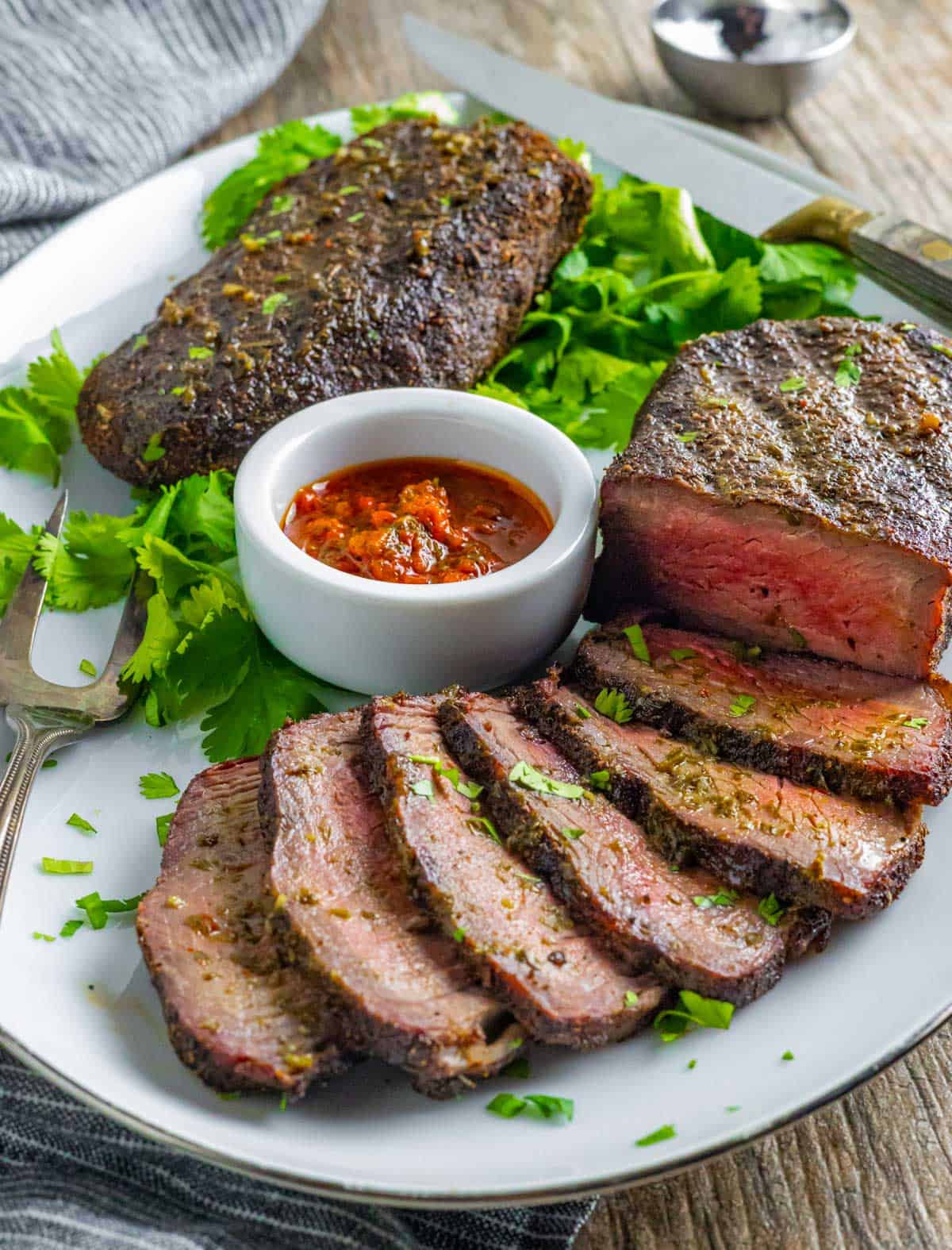
Did you make this recipe? Let me know how you liked it by giving a star rating and leaving a comment!
📖 Recipe
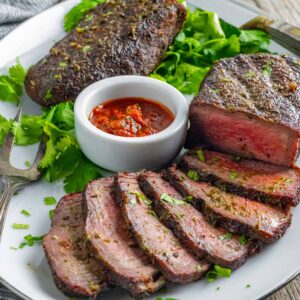
Smoked Sirloin Steak
Ingredients
- 2 top sirloin steaks (about 1 pound each)
- 2 tablespoons dry rub (I recommend my Beef Rub or All-Purpose Seasoning)
Instructions
- Pat the steaks dry with a paper towel.
- Cover all sides with steak rub (dry brining). Dry brining steak brings out natural flavors of meat and improves the texture. Salt draws moisture to the surface, which is then absorbed back into the meat, acting as a natural tenderizer.
- Let marinate for at least 30 minutes before cooking, and up to 24 hours.
- Pre-heat the smoker to 225 °F.
- Place on the grill and smoke until internal temperature reaches 130-135 °F, about 45 minutes.
- Remove from the smoker, cover with foil and increase heat to 450 °F.
- Return the steaks to the smoker and sear for 3 to 3.5 minutes on each side, until internal temp reaches about 145 °F (for medium) or your preferred level of doneness.
- Remove steaks from the grill and rest under foil at least 5 minutes before slicing.
Notes
Expert Tips
- Removing the steak from the grill while the smoker increases temperature between the smoking and searing steps is essential to prevent overcooking.
- Resting is an essential part of the cooking process. The meat increases in temperature during this time (called carryover cooking) and juices get reabsorbed and redistributed in the muscle fibers, creating a moist and flavorful steak.
Nutrition
*Net carbs = carbohydrates - fiber
Nutritional information is an estimate, calculated using online tools and does not include optional ingredients unless otherwise indicated.

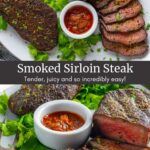
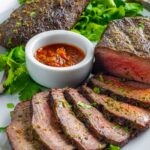
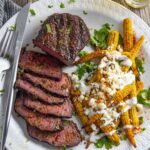
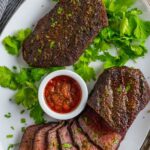
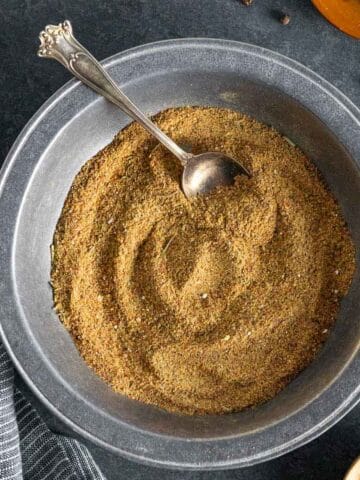
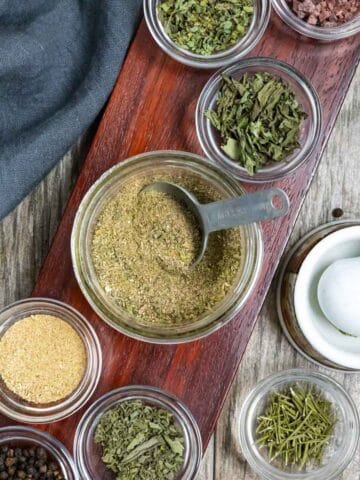
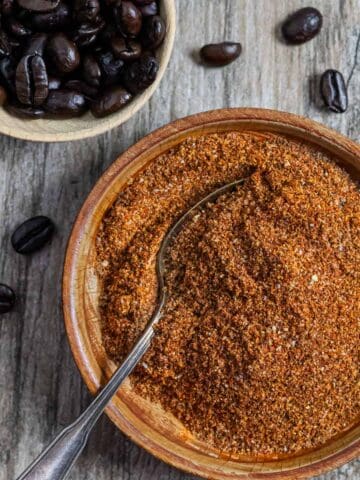
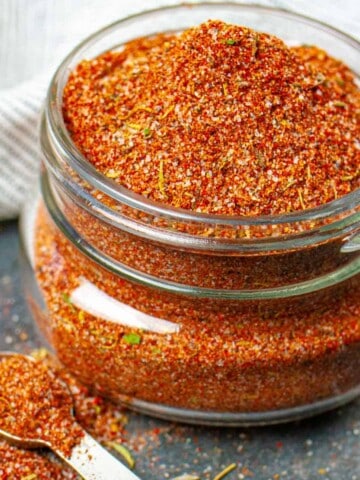
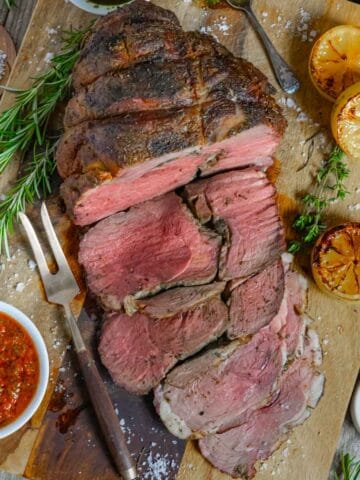
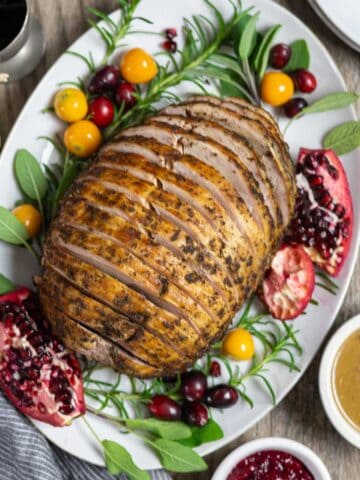
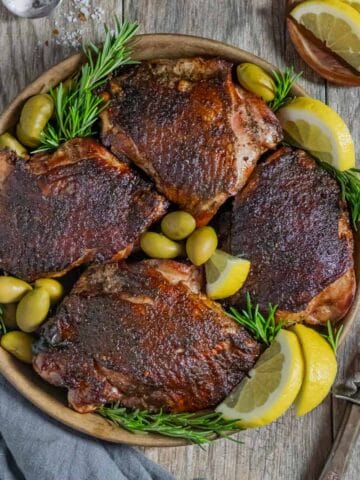
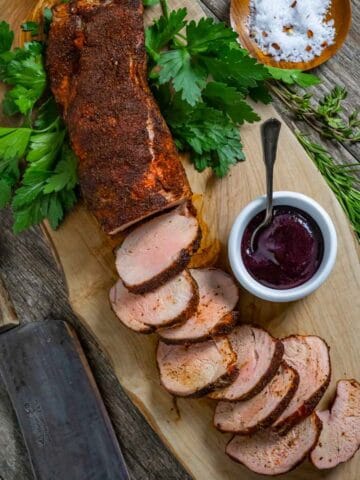
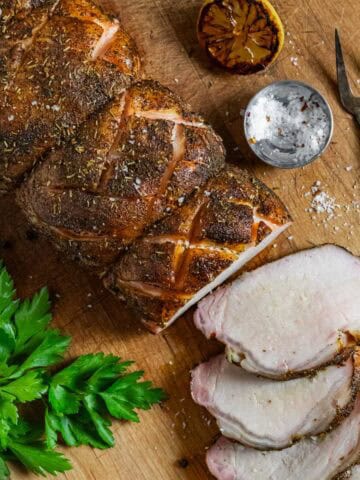
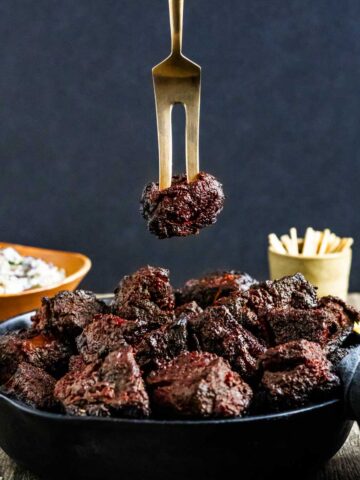
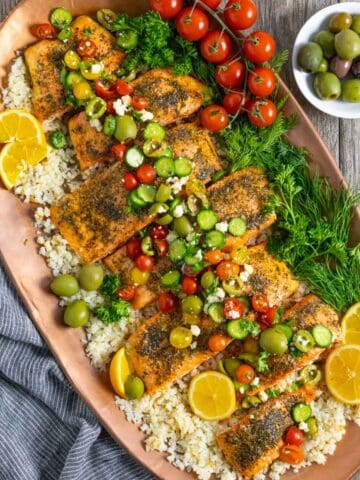
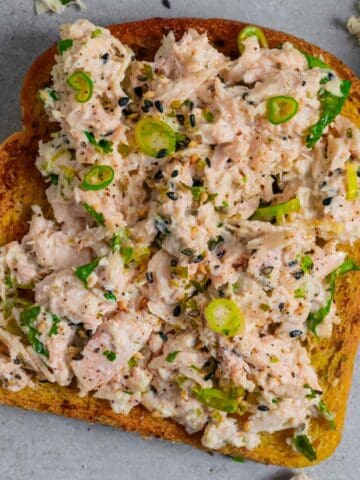
Jo says
I made your beef rub and used it on some 1.5 inch steaks. They were perfect! I'm trying that chimichurri next time.
Tracey Hatch-Rizzi says
Hi Jo,
I'm so happy to hear that you loved your steaks! 1.5" steaks work so well with this recipe. And, I highly recommend either chimichurri recipe - they both are amazing with smoked beef!
Best,
Tracey